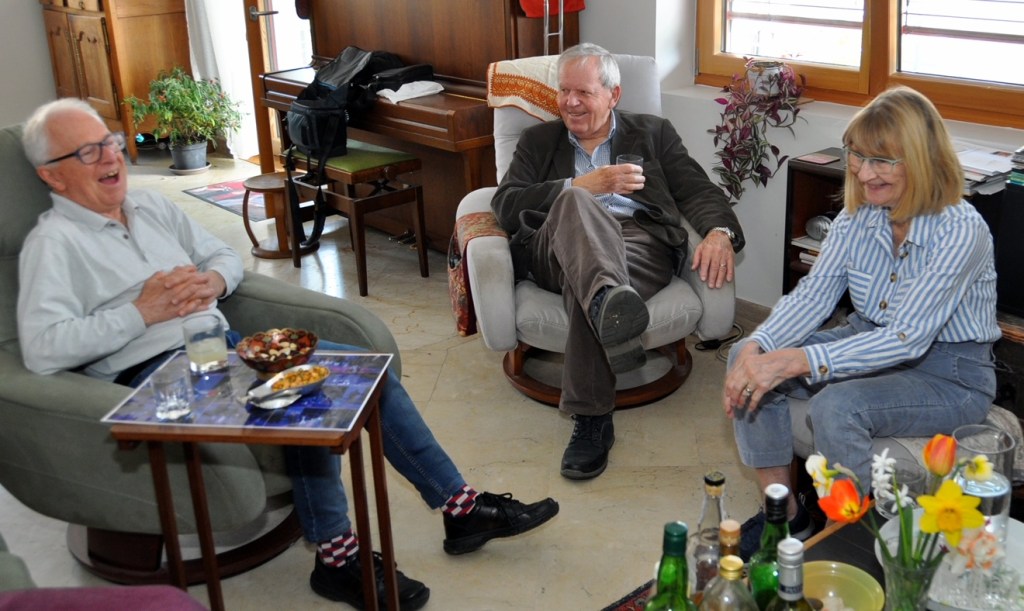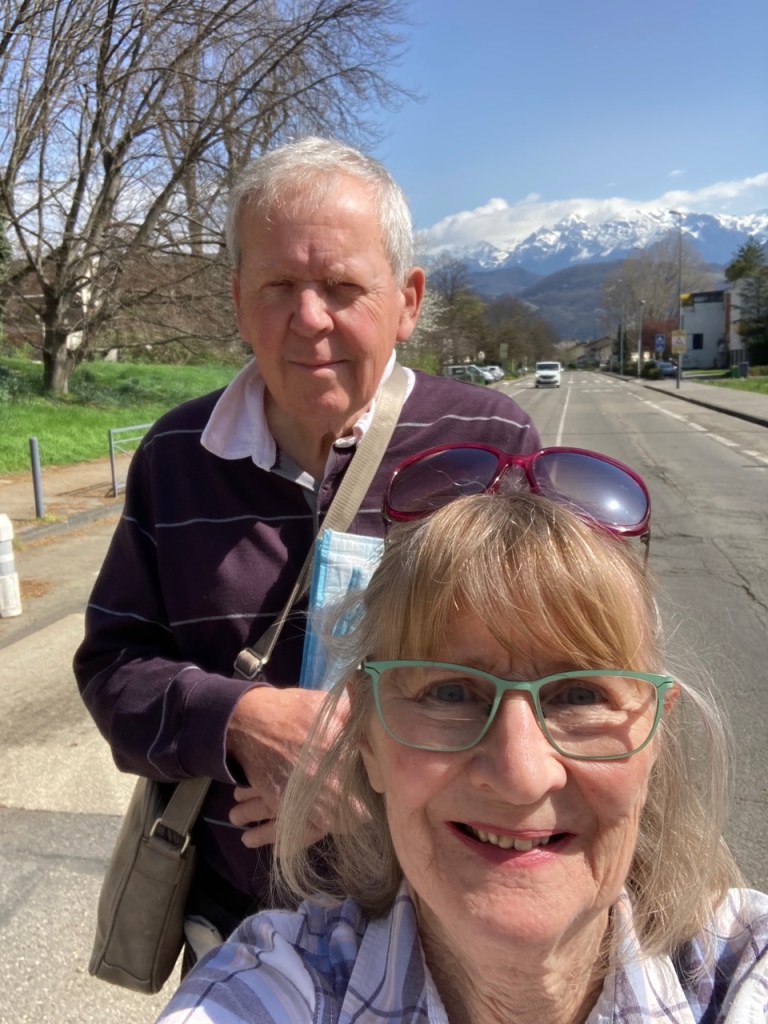Grenoble

Our time here in Grenoble is already drawing to a close. Susie returns to Edinburgh later this week, on Thursday morning. Craig and the girls will arrive in Edinburgh late on [Good] Friday, in time for the memorial event for Craig’s sister, Linsey, which will be held over in Fife on Saturday afternoon. I will be here for the Tenebrae service on Friday evening, held in one of the smaller rooms in St Mark’s Ecumenical Centre; and for the Easter celebration on Sunday morning. And will fly back to Edinburgh, from Lyon airport, later that evening.
We haven’t done everything that we had intended to do. But we have enjoyed our time here, and have been largely blessed with sunshine and blue skies. The French television news, on TF1, bangs on about severe flooding in, mainly, western France, and about an increased avalanche risk. But neither of those things has impacted us here in Grenoble. The worst that has happened is that Susie fell asleep one afternoon on our balcony and woke up with mild sunburn !

For someone who sometimes describes himself, a bit tongue in cheek, as ‘an elderly recluse’, we have spent time with a lot of people. Early on we were invited to lunch by Elizabeth and Jean-Claude, up at Villard-en-Lans, making the journey fearlessly [almost !] on the bus via Sassenage and the Gorge d’Engins. Since then we were invited to lunch by Penny and Jean-Philippe, both world champion rowers, eating outside on their balcony in the sunshine. And this evening we are invited for a meal with Naomi and Cliff, two tram rides away on the north side of the city.

One day we had lunch in town, at Chez Marius, with Cyrille, who was up from Orange visiting a friend. Yesterday I had a return visit to the Musée de la Resistance et de la Déportation, gruelling but very informative; and then we had lunch in la Préf with David, a small restaurant just off the Place de Verdun that was new to all of us.

Here in the apartment Malcolm and Dot came to lunch one day, driving up from Romans-sur-Isère, We first met them in Paris nearly 50 years ago, when Malcolm was attached to the Eglise Reformée in the rue de l’Ouest in the 14ème. Joanna was baptised in that church in the summer of 1977, and Dot was Joanna’s faithful down the years and much appreciated god-mother. It was good too to see Shona who drove over from Lyon with Diana, – Roy had a bug; and we caught up a bit with news from Trinity Church, Lyon. Finally, in what sounds like a long list of convivial eating, Tul and family came to lunch last Saturday, taking the train down from Lyon. We have known Tul since early days in Lyon, when he arrived in church as a refugee, sans papiers and SDF, from Bhutan. He came with Nanymaya, his wife, and their four children of whom he is rightly proud. The eldest, Sara, is already in deuxième, speaks good English, and is thinking about university.

Church life
It is not all meals with friends ! We are here primarily to pastor the St Mark’s congregation. It is invariably difficult for churches when they are without permanent chaplain and have to run with a succession of locum clergy. Without a permanent chaplain it is easy for Sunday attendance to shrink a little, and that has a knock-on effect on church finances. Which enter into a downward spiral. Which then raises questions about the viability of returning to the recruitment and employment of a full-time, stipendiary chaplain.

In addition there is a further issue regarding the changing demography of many congregations in the Diocese in Europe. The number of expat managers, working for British or American multinationals and paid international salaries, has substantially declined. There are significantly fewer families with one or two employed adults and accompanying children. Church attendance figures may have kept up in many chaplaincies, but with a far higher proportion of international students and refugees. And these groups, which bring cultural diversity and a variety of gifts, have only limited financial resources. For Grenoble the arrival of Nick and Julia as a post-retirement, non-stipendiary, [notionally part-time] chaplain was a great blessing.

On Sunday mornings we have felt that the Spirit is moving. Attendance is holding up, even if the time-keeping of many people is a bit random. Clergy are generally unreliable with numbers. I guess there are about 70 adults in church on Sunday morning, at least by the time we finish, and a further 20 or so children. Two Sundays ago there were celebrations and much photography as we celebrated Alan’s 95th and Nell’s 90th birthdays. This past Sunday we celebrated Palm Sunday with an All Age service. Zaz sourced a donkey, which would have been great – but the donkey wouldn’t get into the van. In the absence of the donkey, we marched enthusiastically around the building waving palm [to be precise, laurel] branches. Funmi and Ernest encouraged the Sunday School to share their thoughts with us, and they then taught us a song. And we were entertained by a succession of Palm Sunday Voices: a disciple of Jesus, the owner of the donkey, a senior Jerusalem police officer, a house-proud Jerusalem housewife, and Graham Kendrick.

Outwith Sunday mornings there are prayer meetings on Zoom on Tuesday mornings and lent bible studies, Living with the Psalmist, on Wednesday evenings. Both events were initiated by Roger Simpson, onetime Rector of Ps&Gs, Edinburgh, during his spell as locum. Numbers are quite small. But it has been good to pray for the future shape of ministry here. And also longingly for the awfulness of the situation in the Gaza Strip and the profitless stalemate in Ukraine.
Between Cross and Resurrection
I had intended this blog to be about Alan Lewis’s book Between Cross and Resurrection: a theology of Holy Saturday. His magnum opus published posthumously in 2001. This was to be my ‘serious reading’ for Lent. But in spite of good intentions and an orange marker pencil I have only got to p.261. About halfway through the book.
I embarked on this book because of the references to it in David Smith’s 2020 book, Stumbling towards Zion: Rediscovering the Biblical Tradition of Lament. Alan Lewis reflects on the meaning of Holy Saturday, the hiatus between Good Friday and Easter Sunday when Jesus lay dead in his tomb and his disciples experience the absence of God. For Lewis, the second day [Saturday] provides a buffer against the premature encroachment of the resurrection on the cross. The Westminster Confession and the Apostles Creed both speak of an interval between the cross and Easter. “Christ was not only crucified but dead; not only dead but buried”. Easter Saturday is the boundary between the humiliation of the crucified Christ and the glorious exaltation of Easter Day.
Lewis encourages us “ to make the effort to examine the Cross of Christ from the second day … a story of universal human failure; leaving Jesus alone and isolated, despised and rejected [Isa 55.3]”Jesus is no hero, saviour, or redeemer. He is dead, convicted as a sinner, a rebel, and a blasphemer. Stoning was the Jewish punishment for blasphemy; crucifixion was the Roman punishment for sedition. With unseeing eyes, the Romans had perceived a radical and dangerous subversion.
From here Lewis moves on to the question of identity. Who is this person ? Is he really from God ? Was he mistaken in claiming to be the regent of God’s Kingdom. Is the absence of God in Jesus’ death the failure of divine love ? Subjecting him to unmerited judgement and suffering. Or is it the failure of divine power ? Helpless in the face of evil. In the death cry of Jesus there resonates the ageless, universal protest of human suffering.
Lewis points to the enormous contrast between Good Friday and Easter Day. On Friday Jesus’ cross and burial seem to be the end of everything; the end of hope in God’s justice, power and love. The glory of Easter Day signals the end of darkness and death; the arrival of the kingdom.
In Part II of the book, Thinking the Story, Lewis describes how it became necessary to formalise a summary of the faith inherited from the apostles. Doctrine was necessary to keep the narrative of salvation alive. The precise relationship between Jesus and God the Father was much debated by the early Church, culminating in the Trinitarian formula of the Nicean Creed. But modern theology has complained that patristic theology did not sufficiently acknowledge the humanity of Jesus.
Lewis’s survey of the evolution of Christology brings him to the kenotic theology of two British theologians, PT Forsyth and HR Mackintosh, and thence to Barth and his followers. For Lewis, Eberhard Jüngel, a colleague of Moltmann, is the theologian par excellence of the grave of Jesus Christ. He identifies Easter Saturday as theology’s foundational, defining moment. He majors on the retroactive implication of the resurrection. The empty tomb confirms that it was indeed God on the cross and in the tomb. Easter Sunday establishes the shocking story of the Saturday. God’s whole being is contained in his becoming human, majestic in that very lowliness. So – this is the shocking conclusion of the survey: “that on Easter Saturday in the tomb of Jesus of Nazareth between his crucifying and his raising, God lay dead” [Lewis, p.255]
So what does it mean to live this story in a world threatened by death, and captive still too often to evil and to injustice … … … ? For an answer, watch this space. I have found this book challenging, and often heavy going. Especially the profuse footnotes, which I am learning to ignore. On the back cover of the book, Thomas F. Torrance declares: “this is the most remarkable and moving book that I have ever read”. I hope to finish reading it back in Edinburgh.
Envoi: a prayer request
Getting away from books, Susie has been telling me about her conversation with Z -, who has been doing some cleaning for us these past three weeks. She is a refugee from Armenia. She is delightful, musical, and a Christian. It is always difficult to understand the full story on limited acquaintance. What Susie understood her to say was that she and her husband were forced out of Armenia for reasons that were not clear, that they fled initially to Russia, and have been here in France for at least a decade. Neither she nor her husband have papers, nor any regular employment. They live in a two roomed flat with her daughter, their son-in-law, and grandchild. Her husband is struggling, understandably, with depression. The [limited] good news is that they are being supported by a small community of French réligieuses, with whom they will be spending Easter Day. We pray for them, and for many in similar situations, who find it difficult to see the way forwards, that Easter may bring some hope and some encouragement.

March 2024